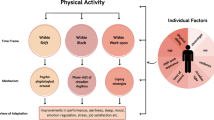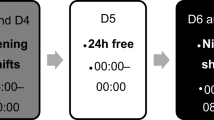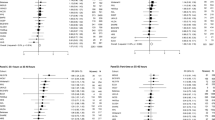Abstract
THE proportion of the working population employed on some form of shift system has increased substantially over the past two or three decades. Expert opinion as to the optimal form of shift system is divided, however, between those who favour ‘permanent’ systems and those who favour ‘rapidly rotating’ ones. We have studied the adaptation of half the members of a socially isolated community to a permanent 8-h shift in their routine. Even in this seemingly ideal situation we failed to find complete adaptation of the ∼ 24-h circadian rhythm in either body temperature or performance efficiency over the 10-d study period. This finding casts some doubt on the theory that permanent shift systems are optimal, and that the light–dark cycle is not important in entraining human circadian rhythms.
This is a preview of subscription content, access via your institution
Access options
Subscribe to this journal
Receive 51 print issues and online access
$199.00 per year
only $3.90 per issue
Buy this article
- Purchase on Springer Link
- Instant access to full article PDF
Prices may be subject to local taxes which are calculated during checkout
Similar content being viewed by others
References
Conroy, R. T. W. L., and Mills, J. N., Human Circadian Rhythms (Churchill, London, 1970).
Blake, M. J. F., Psychon. Sci., 9, 349–350 (1967).
Colquhoun, W. P., Biological Rhythms and Human Performance (edit. by Colquhoun, W. P.), 37–107 (Academic, London, 1971).
Hockey, G. R. J., and Colquhoun, W. P., Aspects of Human Efficiency—Diurnal Rhythm and Loss of Sleep. (edit. by Colquhoun, W. P.), 1–23 (English Universities Press, London, 1972).
Folkard, S., Br. J. Psychol., 66, 1–8 (1975).
Folkard, S., Knauth, P., Monk, T. H., and Rutenfranz, J., Ergonomics, 19, 479–488 (1976).
Aschoff, J., Hoffman, K., Pohl, H., and Wever, R., Chronobiologia, 2 23–78.
Colquhoun, W. P., Blake, M. J. F., and Edwards, R. S., Ergonomics, 11, 437–453 (1968).
Fox, R. H., Woodward, P. M., Fry, A. J., Collins, J. C., and MacDonald, J. C., Lancet, i, 424–427 (1971).
Knauth, P., and Rutenfranz, J., Experimental Studies of Shift Work (edit. by Colquhoun, W. P., et al.), 57–65 (Westdeutscher Verlag, Opladen, 1975).
Wilkinson, R. T., Aspects of Human Efficiency—Diurnal Rhythm and Loss of Sleep (edit. by Colquhoun, W. P.), 25–30 (English Universities Press, London, 1972).
Author information
Authors and Affiliations
Rights and permissions
About this article
Cite this article
HUGHES, D., FOLKARD, S. Adaptation to an 8-h shift in living routine by members of a socially isolated community. Nature 264, 432–434 (1976). https://doi.org/10.1038/264432a0
Received:
Accepted:
Issue Date:
DOI: https://doi.org/10.1038/264432a0
This article is cited by
Comments
By submitting a comment you agree to abide by our Terms and Community Guidelines. If you find something abusive or that does not comply with our terms or guidelines please flag it as inappropriate.



